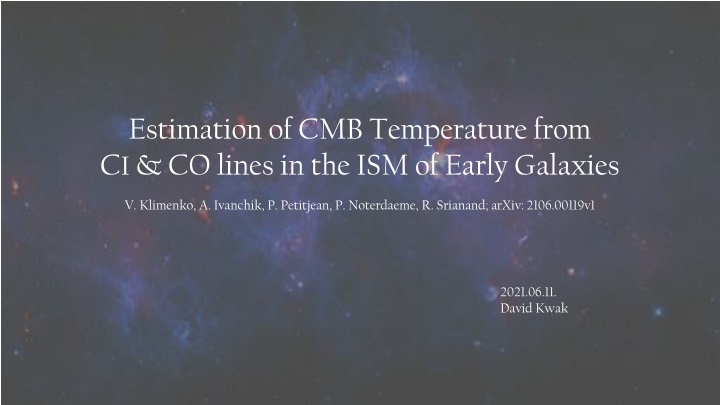
Estimation of CMB Temperature from CI & CO Lines in Early Galaxies
Discover how the Cosmic Microwave Background (CMB) temperature is estimated using atomic CI and molecular CO lines in the Interstellar Medium (ISM) of early galaxies. Explore backgrounds, observations, analysis, results, and discussions related to CMB temperature and measurements in this fascinating study.
Download Presentation

Please find below an Image/Link to download the presentation.
The content on the website is provided AS IS for your information and personal use only. It may not be sold, licensed, or shared on other websites without obtaining consent from the author. If you encounter any issues during the download, it is possible that the publisher has removed the file from their server.
You are allowed to download the files provided on this website for personal or commercial use, subject to the condition that they are used lawfully. All files are the property of their respective owners.
The content on the website is provided AS IS for your information and personal use only. It may not be sold, licensed, or shared on other websites without obtaining consent from the author.
E N D
Presentation Transcript
Estimation of CMB Temperature from CI & CO lines in the ISM of Early Galaxies V. Klimenko, A. Ivanchik, P. Petitjean, P. Noterdaeme, R. Srianand; arXiv: 2106.00119v1 2021.06.11. David Kwak
Table of Contents Backgrounds: - Cosmic Microwave Background - CMB Temperature and Measurements Presented Works: - Observations - Analysis - Results - Discussions
Background Cosmic Microwave Background Contains information about the expansion dynamics of the universe, primordial nucleosynthesis (3 min) & primordial H-He plasma recombination (380000 yrs) Active research concerning: - direct Planck blackbody spectrum & distortions - angular temperature anisotropy - polarization (primordial GW)
CMB Temperature Dependence on Redshift Standard cosmology: ????= ?0(1 + ?) Alternative cosmology (Lima et al. 2000): ? ? = ?0(1 + ?)1 ? No direct observations confirming this relation!
Measuring CMB Temperature Sunyaev-Zeldovich effect - CMB photon interaction with hot electron gas in ISM - high statistics of the number of systems - limited to ? 1 Atomic & molecular energy level excitations - performed using quasar absorption spectrum - applicable to higher redshift - difficult to detect molecular systems in the quasar spectra (~ 4%) - requires quasar spectra with high SNR & spectral resolution
Methods - Observations Atomic CI & molecular CO excitation in early galaxy (? 1.7) 15 damped Lyman- absorption system (DLAs) in regions with high molecular hydrogen column density (log?(?2) > 18) and associated CI absorption lines; CO absorption detected in 6 DLAs Uses high-resolution spectrographs UVES (ESO VLT-UT2) & HIRES
Methods - Analysis For CI: consider collisions between CI and H (atomic & molecular) & He neglect self-shielding of UV radiation (valid because optically thin) background radiation at FIR mostly from CMB ISM homogenous For CO: uniform distribution of molecules two excitation mechanisms: collisions with H & He CMB photons Then, apply Markov chain Monte Carlo method!
Results ? = 0.010 0.013 ? = 2.719 0.009 K (? = 2.7255 0.0006 K; COBE/FIRAS & WMAP) +0.014 weff= 0.991 0.012 (T from Fixsen 2009 & ?0= 0.315 0.007)
Discussions This work is significant because it provides independent estimate for ???? and rather direct evidence to confirm its redshift dependence. No significant evidence for alternative cosmology found through this work. ???? and ???? agrees reasonably with other literatures.
Suggested Readings Difference z-dependence of ???? in alternative cosmological models: Freese et al. 1987; Matyjasek 1995 Atomic & molecular absorption analysis for ???? estimation: Silva & Viegas 2002; Srianand et al. 2008; Noterdaeme et al. 2011
